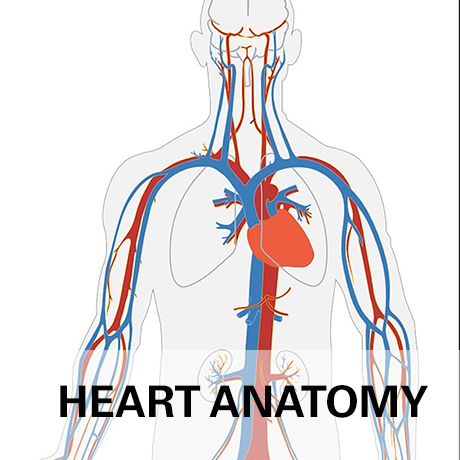Ordered before 1:00PM, same day shipping
SALE - Up to 33% off EEG-Headsets - only while stocks last
Subscribe to our newsletter and get 5€ off for your next purchase in our store.

Free shipping over 100€ (EU)
Buy now, pay later
Free technical Support
Fast Shipping
DIN EN ISO 9001:2015 certified

In order to keep the heart healthy, one has to understand the heart anatomy. Heart disease is one of the most common diseases in Germany. Every fourth death can be attributed to a diseased heart. Regular monitoring of heart function can prevent risks and prevent the worst.
The heart anatomy is perfectly designed to perform a pumping function. The heart is the engine of the human body. Through the heart action, the blood flows into the circulation and supplies the organs with oxygen and essential nutrients. Only a healthy heart anatomy can provide sufficient power to ensure optimal care of the human body. Functioning heart muscle cells, complete closure of the heart valves and adequate heart rate are needed to maintain a stable circulation. The heart rate, that is, the beats per minute, and the volume that flows into the body is increased as needed. Under exertion or during physical activity, up to a five-fold increase in cardiac output is possible. At rest, the human heart pumps 60 to 90 times a minute. About 8000 liters of blood flow through the body. With biofeedback instruments you always have full control over your heart function, can detect deviations and prevent risks at an early stage.
Understanding Heart Anatomy: The Structure of the Heart
The heart is a hollow organ that consists mainly of heart muscle cells. It can be considered as a single, large and powerful muscle that continuously contracts. The contraction carries the blood into the circulation. The heart muscle is called myocardium, inside and outside it is covered with thin skins, the endocardium and the epicardium.
In detail, the heart structure consists of four chambers, which are surrounded by the muscle walls. These are two smaller chambers, the heart atria, and two large chambers, the main chambers of the heart. A dividing wall - the septum - divides the heart organ into right and left heart. In the atria it is referred to as the atrial septum, in the area of ??the main chambers as the septum.
The heart valves separate the atria from the chambers and the chambers from the arteries. There are four heart valves altogether. The tricuspid valve is located between the right atrium and the right ventricle, the pulmonary valve dividing the right chamber from the pulmonary artery. In the left heart, the bicuspid valve is located between the atrium and the chamber; the aortic valve forms the border between the chamber and the aorta, the main artery of the human body. The opening and closing of the heart valves, as well as the turbulence of the blood caused by the pumping action, are registered when the heart is being monitored with a stethoscope.
The heart function is triggered by the sinus node. These are specialized cardiomyocytes located in the right atrium at the junction of the vena cava. This cell accumulation acts as a physiological pacemaker. The cells generate electrical excitations, which spread over the conduction pathways first to the heart valves and the atrioventricular node (AV node) and then run branched over the entire heart and ultimately cause the contraction. An electrocardiogram (ECG) records this excitation in the heart.
By selecting "Accept all", you give us permission to use the following services on our website: YouTube, Vimeo, ReCaptcha, Brevo, Matomo-Webanalytics, "OSS Lieferland" Geo-Ip Service, Microsoft Advertising, Facebook Pixel, Google Analytics 4, Google Ads Conversion Tracking. You can change the settings at any time (fingerprint icon in the bottom left corner). For further details, please see Individual configuration and our Privacy notice.
The settings you specify here are stored in the "local storage" of your device. The settings will be remembered for the next time you visit our online shop. You can change these settings at any time (fingerprint icon in the bottom left corner).
For more information on cookie lifetime and required essential cookies, please see the Privacy notice.
To view YouTube contents on this website, you need to consent to the transfer of data and storage of third-party cookies by YouTube (Google). This allows us to improve your user experience and to make our website better and more interesting. Without your consent, no data will be transferred to YouTube. However, you will also not be able to use the YouTube services on this website.
To view Vimeo contents on this website, you need to consent to the transfer of data and storage of third-party cookies by Vimeo.. This allows us to improve your user experience and to make our website better and more interesting. Without your consent, no data will be transferred to Vimeo. However, you will also not be able to use the Vimdeo services on this website.
To submit forms on this page, you need to consent to the transfer of data and storage of third-party cookies by Google. With your consent, reCAPTCHA, a Google service to avoid spam messages via contact forms, will be embedded. This service allows us to provide our customers with a safe way to contact us via online forms. At the same time, the service prevents spam bots from compromising our services. After you gave your permission, you might be asked to answer a security prompt to send the form. If you do not consent, unfortunately you cannot use the form. Please contact us in a different way.
To send data to Brevo, you need to consent to the transfer of data and storage of third-party cookies by Brevo. This allows us to improve your user experience and to make our website better and more interesting.
Recording and evaluation of visitor and purchasing behavior
The Geo-Ip service is used only to determine the country from which the user is visiting this site in order to automatically display country-specific tax rates and prices.
Country determination for country-specific tax rates]]
Processing company:ip2c.org
Terms of use: LinkUm Daten an Microsoft zu übermitteln, ist Ihre Zustimmung zur Datenweitergabe und Speicherung von Drittanbieter-Cookies des Anbieters Microsoft erforderlich. Dies erlaubt uns, unser Angebot sowie das Nutzererlebnis für Sie zu verbessern und interessanter auszugestalten.
Tracking mithilfe von Microsoft Advertising
Processing company:Microsoft
Terms of use: LinkFacebook ist ein Online-Social-Networking-Dienst, der es seinen Nutzern ermöglicht, sich mit Freunden und Familie zu verbinden.
Zweck der Datenverarbeitung: Marketing
Hinweise zur Nutzung von Cookies über den Dienst "Facebook" finden Sie hier: https://de-de.facebook.com/policy.php
Kategorien verarbeiteter Daten:
Klickpfad,Sichtbarkeit von Anzeigen messen,Mausbewegung,Zeitstempel,Klicks auf Anzeigen verfolgen,Uhrzeit und Datum verfolgen,Verfolgen des Benutzergeräts,Tracking des Benutzernetzwerks,User-Agent,Sprache,Besuchte Webseite, Zeitzone
Rechtsgrundlage für die Datenverarbeitung: Einwilligung (DSGVO 6.1.a)
Datenübertragung außerhalb der EU:
Dieser Anbieter kann Ihre personenbezogenen Daten außerhalb des EWR/der EU übertragen, speichern oder verarbeiten. Diese Länder haben möglicherweise nicht das gleiche Datenschutzniveau und die Durchsetzung Ihrer Rechte kann eingeschränkt oder nicht möglich sein.
Meta Platforms Ireland Limited, 4 Grand Canal Square, Grand Canal, Dublin 2, Dublin, D02x525, IE
Terms of use: LinkDies ist ein Webanalysedienst.
Erhobene Daten: anonymisierte IP Adresse, Datum und Uhrzeit des Besuchs, Nutzungsdaten, Klickpfad, App-Aktualisierungen, Browser Informationen, Geräte-Informationen, JavaScript-Support, Besuchte Seiten, Referrer URL, Standort-Informationen, Kaufaktivität, Widget-Interaktionen
Analyse
Processing company:Google Ireland Ltd, Gordon House, Barrow Street, Dublin 4,IE
Terms of use: LinkMit dem Google Ads Conversion Tracking können wir unseren Werbeerfolg im Google Werbenetzwerk messen. Wir schalten Werbung im Google Werbenetzwerk, damit unsere Angebote besser gefunden werden. Wir versuchen dabei Werbung so optimal wie möglich zu gestalten. Auch um Werbekosten so gering wie möglich zu halten. Dies spiegelt sich in unseren Preisen wieder ;)
Erhobene Daten: zufallsgenerierte USER-ID
Marketing
Processing company:Google Ireland Ltd, Gordon House, Barrow Street, Dublin 4,IE
Terms of use: LinkWould you like to see these contents? Activate the desired contents for one session only or allow the website to remember these settings. Once you have given your consent, the third-party data can be loaded. For this, third-party cookies might be stored on your device. You can change these settings at any time (fingerprint icon in the bottom left corner). For further details, please see the Privacy notice.
| id | title | mpn | price | manufacturer |
|
from *
/
|

